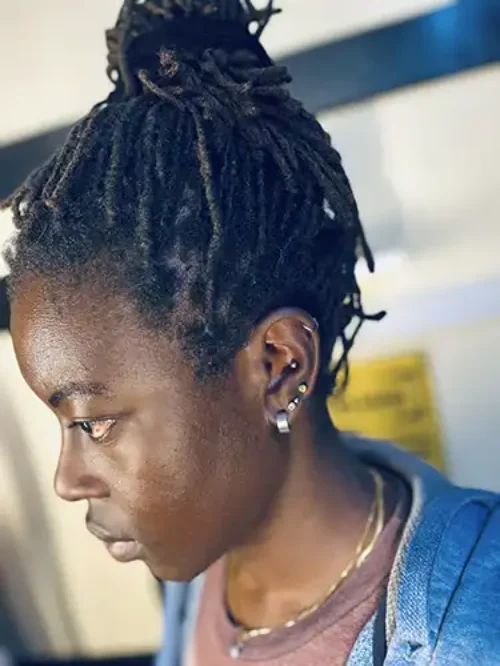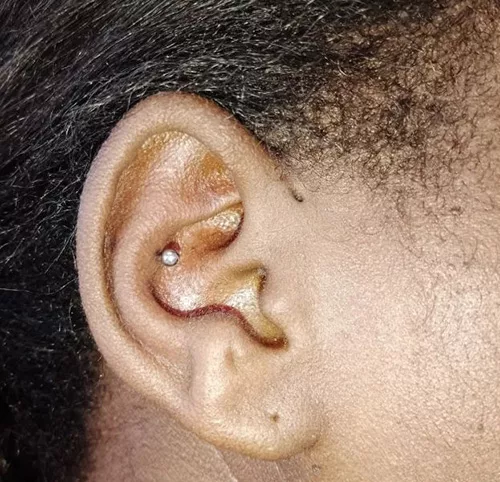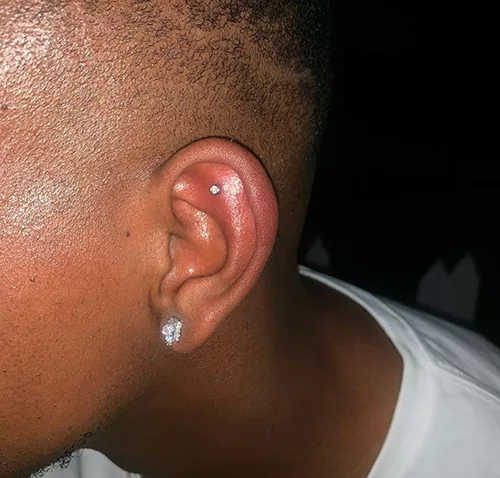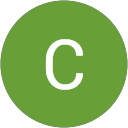Conch Piercing in Nairobi, Kenya
A conch piercing is a type of ear piercing that goes through the cartilage of the ear’s concha, the inner shell-like part of the ear. It’s a versatile piercing because it can be done in various locations within the concha, such as the inner or outer conch. Depending on your preference, you can adorn it with different types of jewelry, like studs, hoops, or rings. It’s a trendy piercing choice and can add a unique touch to your ear aesthetics.

Conch Piercings FAQ’s
Conch piercings are a type of cartilage piercing that’s named after the large spiral shape that ears take after. There are different options for jewellery kind (stud or hoop) and placement (inner versus exterior) in the world of conch piercings.
Right in the centre of your cartilage, your conch has a spiral shape that somewhat resembles a conch shell. When getting your conch pierced, depending on the anatomy of your ear, you may have more room on the higher fold (which is ideal for studs) or the lower fold (which looks great with hoops).
An inner conch piercing involves making a hole directly through the centre of the ear to accommodate a stud. Another option is the outer conch piercing, which enables a ring to wrap around the cartilage on the outside of the ear (hoop earrings).
Piercing Placement
- Inner Conch: An inner conch piercing is placed closer to the ear canal, often with a stud or hoop placed horizontally.
- Outer Conch: An outer conch piercing is closer to the outer rim of the ear and can accommodate various jewelry styles.
Considerations before getting an Conch Piercing
Before getting a conch piercing, it’s important to carefully consider several factors to ensure you make an informed decision and are prepared for the process and aftercare. Here are some considerations to keep in mind:
- Professional Piercing Studio: Research reputable piercing studios in your area. Look for studios with experienced, professional piercers who follow strict hygiene and safety practices.
- Piercer’s Qualifications: Ensure that the piercer is trained, licensed, and experienced in performing conch piercings. Ask to see their portfolio of previous work.
- Piercing Placement: Discuss the placement of the conch piercing with your piercer. Decide whether you want an inner conch or outer conch piercing, as the location can affect the appearance and jewelry options.
- Pain Tolerance: Be prepared for some pain and discomfort during the piercing process. While it’s usually brief, everyone’s pain tolerance is different.
- Healing Time: Understand that conch piercings can take several months to a year or more to fully heal. Proper aftercare is crucial during this period.
- Aftercare Commitment: Be ready to follow the aftercare instructions provided by your piercer diligently. This may include cleaning the piercing with a saline solution, avoiding touching the piercing with dirty hands, and not submerging it in water during the healing phase.
- Swelling and Redness: Expect some swelling and redness around the piercing site, especially in the initial days and weeks following the piercing.
- Jewelry Options: Discuss jewelry options with your piercer. Conch piercings can accommodate various styles, including studs, hoops, captive bead rings, and barbells. Choose high-quality jewelry made from materials like surgical steel, titanium, or biocompatible materials.
- Infection Risk: Understand the risk of infection and other complications. Proper aftercare is essential to minimize these risks.
- Cartilage Bumps: Be aware that some individuals may develop cartilage bumps or keloids around the piercing site. Consult your piercer or a dermatologist if you have concerns.
- Lifestyle Considerations: Consider how the piercing may impact your daily life, such as wearing headphones or ear protection. Conch piercings can be more noticeable and can affect these activities.
- Personal Style: Conch piercings can be a stylish and versatile way to express your individual style, but be sure to choose a location and jewelry that align with your aesthetic preferences.
- Consultation: Before getting the piercing, have a consultation with your chosen piercer to discuss your expectations, ask any questions, and receive personalized advice on placement and jewelry selection.
- Future Plans: Consider any future plans or career goals that may be affected by the piercing. Some professions or workplaces have strict policies regarding visible piercings.
Conch Piercing Procedure
The conch piercing procedure typically involves the following steps:
- Consultation: Before getting the piercing, you’ll have a consultation with one of our professional piercer. They will assess your ear anatomy, discuss placement options, and answer any questions you may have.
- Sterilization: Our piercer will clean the area around your ear with an antiseptic solution to reduce the risk of infection. They may also mark the piercing location with a surgical pen to ensure accuracy.
- Piercing: Once the area is clean and marked, our piercer will use a hollow needle to create the piercing. They’ll swiftly insert the needle through the concha cartilage, creating a channel for the jewelry.
- Jewelry insertion: After the piercing is made, our piercer will immediately insert the chosen jewelry into the newly created hole. This is typically done using sterile tools to minimize the risk of infection.
- Aftercare instructions: Our piercer will provide you with detailed aftercare instructions to promote healing and prevent complications. This may include cleaning the piercing with saline solution, avoiding certain activities that could irritate the piercing, and following a proper cleaning routine.
- Follow-up: It’s essential to follow up with our piercer if you experience any issues or have questions during the healing process. They can provide guidance and address any concerns you may have.
It’s crucial to have your conch piercing done by a professional piercer who follows strict hygiene and safety protocols to minimize the risk of infection and ensure a successful piercing experience.

Conch Piercing Pain and Healing
The pain experienced during a conch piercing can vary depending on individual pain tolerance and the specific technique used by the piercer. Generally, conch piercings are considered to be moderately painful due to the thickness of the cartilage in the concha area. Some people describe the sensation as a sharp pinch or pressure during the piercing process.
As for the healing process, conch piercings typically take longer to heal compared to earlobe piercings due to the thicker cartilage tissue involved. Here’s a general timeline for the healing stages:
- Initial healing (6-8 weeks): During the first few weeks, the pierced area may be tender, swollen, and slightly red. It’s common to experience some discharge, crustiness, and mild discomfort. Proper aftercare, including cleaning the piercing regularly with saline solution and avoiding irritation, is crucial during this stage.
- Intermediate healing (2-4 months): As the piercing continues to heal, the swelling and tenderness should gradually decrease. However, it’s essential to continue following the aftercare instructions provided by your piercer to prevent infection and promote proper healing.
- Full healing (6-12 months): Complete healing of a conch piercing can take up to a year or more. Even though the piercing may appear healed on the outside, the cartilage tissue inside the ear takes longer to fully heal. It’s essential to continue practicing good hygiene and avoiding trauma to the piercing site during this time.
Throughout the healing process, it’s normal to experience some ups and downs, including minor setbacks such as irritation, redness, or the formation of keloids or hypertrophic scars. If you experience any severe pain, excessive swelling, or signs of infection (such as pus, severe redness, or fever), it’s important to seek medical attention promptly.
Remember to be patient and gentle with your conch piercing during the healing period, and don’t hesitate to reach out to your piercer if you have any concerns or questions.
Conch Piercing Aftercare
Proper aftercare is essential for ensuring the healing and health of your conch piercing. Here’s a guide to conch piercing aftercare:
- Cleanliness: Wash your hands thoroughly with soap and water before touching your piercing. Avoid touching the piercing unnecessarily, especially with dirty hands.
- Saline solution: Use a saline solution or a saline-based wound wash to clean your piercing. You can either buy a pre-made saline solution or make your own by mixing non-iodized sea salt (about 1/4 teaspoon) with warm distilled water (8 ounces). Soak a cotton ball or pad in the saline solution and gently clean around the piercing, removing any crust or discharge.
- Avoid rotating the jewelry: Unlike traditional wisdom, rotating the jewelry can cause trauma to the healing tissue. Let the piercing be unless you’re cleaning it.
- Avoid harsh products: Avoid using alcohol, hydrogen peroxide, or other harsh chemicals on your piercing, as they can irritate the skin and delay healing.
- Avoid submerging in water: Avoid submerging your piercing in bodies of water such as pools, hot tubs, or lakes until it’s fully healed to prevent infection.
- Hair care: Keep hair products like shampoo, conditioner, and hairspray away from the piercing site. Hair can also get caught in the jewelry, so tie your hair back or away from the piercing during the healing process.
- Avoid trauma: Be careful with headphones, earbuds, hats, and clothing that may snag on your piercing. Try to sleep on the opposite side of the piercing to avoid putting pressure on it.
- Watch for signs of infection: Keep an eye out for signs of infection, such as excessive redness, swelling, pain, warmth, or discharge that is yellow, green, or foul-smelling. If you suspect an infection, seek medical attention promptly.
- Follow-up: Follow any specific aftercare instructions provided by your piercer. They may recommend additional steps based on your individual healing process.
- Patience: Healing times vary from person to person, so be patient with your piercing. It may take several months to a year for your conch piercing to fully heal.
If you have any concerns or questions about your piercing or its aftercare, don’t hesitate to reach out to our piercer for guidance.
Conch Piercing Jewelry
There are various types of jewelry options available for conch piercings, allowing for customization and personalization. Here are some popular choices:
- Studs: Studs are a classic choice for conch piercings. They come in various designs, including simple studs with gemstones, flat-back studs, or decorative studs with unique shapes or designs.
- Hoops: Hoop earrings can also be worn in conch piercings. Captive bead rings (CBRs) and seamless rings are common hoop styles for conch piercings. They can add a stylish and trendy look to your piercing.
- Barbells: Barbell-style jewelry consists of a straight bar with a ball or decorative end on each side. This type of jewelry is often used for industrial piercings but can also be worn in conch piercings, particularly in the inner conch.
- Hinged rings: Hinged rings, also known as clicker rings, are easy to open and close, making them convenient for insertion and removal. They come in various designs and materials, allowing for a stylish and secure option for conch piercings.
- Labret studs: Labret studs feature a flat back and a decorative or ball end on the front. They are versatile and comfortable for conch piercings, especially if you prefer low-profile jewelry.
- Custom jewelry: Some piercers offer custom jewelry options, allowing you to create a unique piece tailored to your preferences. Custom jewelry can include intricate designs, unique gemstones, or personalized engravings.
When selecting jewelry for your conch piercing, consider factors such as material, size, style, and comfort. It’s essential to choose high-quality jewelry made from biocompatible materials like titanium, surgical steel, or gold to minimize the risk of irritation or allergic reactions. Additionally, ensure that the jewelry fits properly and complements your individual style and preferences. If you’re unsure about which jewelry option is best for your conch piercing, consult with your piercer for guidance and recommendations.
Cost of a Conch Piercing
The cost of a conch piercing can vary depending on several factors, including the location of the piercing studio, the expertise of the piercer, the quality of the jewelry used, and any additional services provided.
Factors that may influence the cost:
- Piercing studio reputation: At Rebel Inks Tattoos, Tattoo Removal, and Body Piercings Parlour we have piercers with extensive experience and expertise in genital piercings, our piercing services may command higher fees compared to others. It’s essential to choose a piercer who is skilled, knowledgeable, and follows strict hygiene practices to ensure a safe and successful piercing experience.
- Location: Piercing studios in different areas may have varying price ranges. Rebel Inks Tattoos, Tattoo Removal, and Body Piercings Parlour is located in the heart of the Central Business Disrict (CBD) in Nairobi, Kenya, and is easily accessible to both locals and foreigners in the country
- Jewelry quality: The cost of the piercing may include the price of the initial jewelry, which can vary depending on the type, material, and quality of the jewelry chosen. High-quality jewelry made from surgical-grade stainless steel, titanium, or gold may be more expensive than lower-quality options.
- Additional services: At Rebel Inks Tattoos, Tattoo Removal, and Body Piercings Parlour our piercers may offer additional services or perks as part of the piercing package, such as consultation fees, aftercare products, or follow-up appointments. These services can impact the overall cost of the piercing experience.
Conch Piercing Price Breakdown Table
Service Component | Estimated Cost (KSh) | Details / Notes |
Piercing + standard jewelry | 1,500–2,500 | Basic stainless or titanium stud likely included |
Premium upgrade (titanium/niobium) | 500–1,000 | Hypoallergenic higher-grade jewellery |
Gold or designer jewellery | 1,500–3,000 | Stylish, gem-set designs cost more |
Aftercare kit (saline spray, balm) | 500–1,500 | May be included; some studios charge separately |
Check-up or jewelry downsizing visit | 500 | Post-healing follow-up service |
Additionally, At Rebel Inks Tattoos, Tattoo Removal, and Body Piercings Parlour we at times offer package deals or discounts for multiple piercings, so it’s worth Contacting Us and inquiring about any specials or promotions that may be available.
Possible side effects of Conch Piercing
While conch piercings are generally safe when performed by a professional piercer using proper techniques and sterile equipment, there are potential side effects and risks to be aware of:
- Pain and swelling: It’s normal to experience some pain, swelling, and tenderness around the piercing site, especially in the first few days after getting pierced. However, excessive pain or swelling may indicate a problem and should be addressed with your piercer or a healthcare professional.
- Infection: Like any piercing, conch piercings carry a risk of infection. Symptoms of infection may include redness, warmth, swelling, pain, and discharge that is yellow, green, or foul-smelling. If you suspect an infection, seek medical attention promptly.
- Keloids or hypertrophic scarring: Some people are prone to developing keloids or hypertrophic scars, which are raised, thickened scars that can form around the piercing site. Proper aftercare and avoiding trauma to the piercing can help reduce the risk of scarring.
- Allergic reactions: Allergic reactions to the metal in the jewelry used for the piercing are possible, especially if you have sensitivities to certain metals like nickel. Choosing high-quality, hypoallergenic jewelry made from materials like titanium or gold can help minimize the risk of allergic reactions.
- Migration and rejection: In some cases, the body may reject the piercing, leading to migration or the piercing moving outward from the skin. This can happen if the body perceives the piercing as a foreign object. Proper aftercare and avoiding trauma to the piercing can help prevent migration and rejection.
- Cartilage damage: Piercing through cartilage carries a risk of damaging the cartilage tissue, which can lead to complications such as deformity or permanent damage to the ear. It’s essential to have your conch piercing performed by an experienced piercer who understands the anatomy of the ear and uses proper techniques.
To minimize the risk of complications and ensure a successful piercing experience, follow your piercer’s aftercare instructions, avoid touching or twisting the jewelry, and seek medical attention if you experience any unusual symptoms or complications.
Related Piercing
Get In Touch
For more information on the list above and any other special services,please call or come in for free consultation
Testimonials
I am extremely happy with my new 'Safari' tattoo from Eric at Rebel Inks! The quality of the artwork is fantastic. Eric is a true professional and an amazing artist.
The preparation and design process was thorough and collaborative. He was very patient with my specific requests, including making sure all the elements, which hold personal meaning, were perfect.
The service was friendly and highly professional from start to finish. Despite the 8-hour session, Eric was a pleasant person to spend the time with.
The aftercare guidance and follow-up have been excellent and careful, which has made the healing process easy and better than expected.
I highly recommend Eric for anyone looking for a thoughtful, talented, and caring tattoo artist.
I recommend them 💯
I would definitely recommend if you’re thinking of getting a piercing!
The staff were super friendly, explained everything clearly, and made me feel so at ease. They answered all my nervous questions (and I had many questions),
They walked me through the whole process, gave detailed aftercare instructions, and even followed up afterward to check how I was healing 🫶
Clean, professional, and full of good vibes.
Would 100% recommend . Definitely making a second trip here.
This was the second tattoo I got and I wish I could have come to Eric for my first one! He gave me really great after-care directions for the tattoo as well as a little jar of his own Vaseline-type stuff to put over my tattoo while it was healing! He even put second skin over my tattoo so that I didn’t have to worry about it for the first few days. Now THAT’S good service. My first tattoo artist didn’t do none of that lol.
After the session Eric didn’t rush me and my friend out, he chatted with us and even when he found out I was an artist too— really encouraged me to keep creating and to find a community of artists to support me. I almost cried because I’ve had such a hard time with my own art the past couple of years, it meant so much to me to have a fellow very talented artist say that to me. 🤍🤍🤍
Eric you’re amazing, don’t ever stop creating and just know you’ve impacted lives all over the world!🫶🏻 thanks so much for everything!!
From the moment I walked in, Eric was professional, welcoming, and attentive. He made sure I was comfortable throughout, provided everything I needed, and explained every step of the process. The tattooing itself was unbelievably smooth - I genuinely felt no pain compared to my previous tattoos over the last 22 years.
Eric also gave me excellent aftercare guidance and products, and thanks to that, my tattoo healed beautifully. The attention to detail, precision, and shading are absolutely stunning. This is hands-down the best tattoo I've ever had, and I will be flying back to Nairobi for any future ink.
If you want incredible art, a professional experience, and a talented artist who truly cares about his clients, Rebel Ink is the place to go!
From start to finish, the service was exceptional. The piercer was professional, knowledgeable, and made me feel completely comfortable. The cleanliness of the place was above and beyond — everything was spotless and hygienic, which really put me at ease. Highly recommend for anyone considering a piercing!
Shout out to Eric😘
We ended up changing the jewelry three times to ensure I had the best fit and avoided any signs of rejection, and he always listened to my suggestions as a client, which I really appreciated. Now, three months in, my piercing is healing beautifully, with no sign of rejection. Highly recommend for anyone who values a piercer who cares about your comfort and healing journey!
What stood out the most was the aftercare Eric checked in with me even three weeks later to see how the tattoo was healing. That kind of follow-up shows how much he truly cares about his work and his clients.
I’m very satisfied and will definitely be coming back for my next piece. Highly recommend!
The piercing wasn't as painful as I had thought and the process was quick and satisfactory. I love it!!!
The piercing is healing well thanks to the aftercare instructions and follow-up. I would highly recommend Rebel Inks
Eric also did a belly button piercing for a friend, guiding her through the process, doing the piercing and then explaining the after care to her.
The shop is on the 3rd floor, with the entrance to the stairs near an alleyway on the left. The shop is perfect size, clean, and attractive looking. The mural is pretty dope.
Thank you for the amazing service! 🔥👅✨
I got piercibgs there and the process was really good. My biggest concern was hygiene but that wasn't an issue at all, they use new needles and they sanitize them.
The service itself was also welcoming.
I was informes of everything i needed to know beforehand.
10/10 would recommend!
Eric was so calm and patient with my almost 2 year old lady. It was such a clean and hygienic process. We will definitely be back for our second rounds of piercings and maybe even another tattoo!
They assess the area before any art and advise one accordingly. They also give one post clean up process and also do a check up after the body art projects. Overall, I loved my experience and I’m hooked. 👍
Will definitely come back next time I’m in town 🙂
He listened to what I actually wanted and made sure he could fit in the time before I flew back home.
The shop is clean & private and is easy enough to find.
Eric has even checked in a couple of times since to make sure all is good.
I would totally recommend Eric! I absolutely love my Elephants!
I had a very easy healing period and always follow up from Eric to check on my progress...I would highly recommend if you are a first timer because from my experience all went very well and attention to detail
Thank you for a good job and looking forward to send all my friends your way
And all the best with the new year 2025!
From the moment I walked in, the staff was super friendly and made me feel at ease. The studio had a clean, professional atmosphere, which immediately put me at ease. My piercer was incredibly skilled and explained every step of the process, ensuring I was comfortable the entire time. The piercing was quick and practically painless, and the aftercare instructions were clear and easy to follow. I can tell they really care about the health and safety of their clients.
Overall, a fantastic experience—I highly recommend Rebel Inks and Tattoos for anyone looking to get pierced or tattooed!
They do follow up after their services
Eric's Studio isn’t just a place to get a tattoo—it’s an experience. The combination of professionalism, artistic talent, and a welcoming environment makes it a standout destination for anyone considering a tattoo.
I highly recommend Eric’s Studio to both first-timers and seasoned tattoo enthusiasts. If you’re looking for a high-quality tattoo and an enjoyable experience, this is the place to go.
I would definitely recommend their services again and again
Thank you Rebel Ink
My piercings are healing ❤️🩹 well
I would 💯 recommend
I will definitely come back for more .
Two, all the equipments he used for the piercings were new and/or sterilised.
Three, the parlour itself was very clean and was up to par with the hygiene standards.
Four, Eric provided effective aftercare instructions, making sure I knew exactly how to take care of my new piercings and he kept in touch and continues to do so, to check on the healing progress.
I highly highly highly recommend this place!!!
Would definitely recommend them to friends and go back for other piercings
Not only was the piercing process smooth, but he also provided thorough aftercare instructions, making sure I knew exactly how to take care of my new piercings. What really impressed me was that he keeps in touch to check on how the healing is progressing – a sign of true care for his clients.
The shop maintains a high standard of hygiene, and the atmosphere is welcoming and comfortable, which really added to the positive experience. I highly recommend this place to anyone looking for a professional and caring experience. I’ll definitely be coming back for any future piercings!
My appreciation for the excellent customer service I received. The follow-ups were prompt, and I truly appreciated the gentleness and professionalism throughout. Thank you!"
"Looking for professional eyebrow microshading removal? Look no further!"
The customer care is top tier 👌🏾👌🏾.
Wonderful place to get tattoos and piercings. 💯💯
Eric goes ahead to follow up on his clients progress and gives good advice each time I reach out to him.
I would recommend Reble tattoos anytime.
Good job bro we really appreciate.
Ohh and the price is very fair.
The environment was clean , procedure was sterile and the jewelry used are of the best quality.
He followed up with me during the healing process, he educated me on what I needed to do for my aftercare.
Eric is confident, skilled , experienced and the best piercer. Highly recommend Rebel inks.✨
Definitely recommend!
Great experience.
Eric definitely know what he is doing .
I got exactly what I wanted 2 tiny tats on the same finger .
He was kind and patient throughout the session.
Healing process has been good .
Aftercare services were given and regular checkups on the healing process were done.
I would 💯recommend.
Eric gave me the best reception as it was my first time there,and made me trust him all the way. I appreciate good services.
There services are also affordable not to forget 😊.
He was also invested in the aftercare and would ensure I follow the do's and don'ts in taking care of the tattoo and ensuring proper healing and maximum ink retention.
Would highly recommend Rebel Inks Tattoos.
Rebel Inks Tattoo offer the best,affordable and quality tattoo removal services.If you have unwanted ink,choose Rebel Inks Tattoo,they're the best of the best and the professionalism is a top notch.They ensure you're free from unwanted ink with their Laser Tattoo Removal Technology...
I did a Laser Tattoo Removal with them and i can attest they're the best....
Kudos Eric...
I highly recommend.
It was a generally good experience with good hygiene during the piercing process and has been a smooth healing process.... 10/10
tips. Highly recommend 👍🏽
100% recommendable.
I was particularly impressed with Eric's attention to hygiene. He thoroughly cleaned the room before I entered, sanitized all of the equipment he would be using, and changed gloves between each ear. This level of cleanliness gave me great confidence in his professionalism.
Eric's commitment to customer service did not end on the day of the piercing. He followed up with me regularly throughout the healing process to ensure that I was following the aftercare instructions and that my earlobes were healing properly.
I highly recommend Rebel Inks to anyone in Nairobi who is considering getting a piercing. Eric is a highly skilled and experienced piercer who takes great pride in his work.
So I Check all the boxes below and more:
Customer Care: ✔️
Professionalism : ✔️
Cleanliness ✔️
Price: ✔️
After care service ✔️
Thanks and good job, Eric
The place is neat and clean and the equipments he used were also fine standards. Really appreciate his following up with me on the healing 🤗
I WOULD HIGHLY RECOMMEND THEIR SERVICES to everyone. Actually what you see on their website is EXACTLY what you will get. Keep up the good work Rebel inks Tattoos.
The infection is now gone. I would definitely recommend!
Can recommend this place totally and would go back there anytime!
Thanks!
OUR LOCATION
Areas We Serve
NAIROBI
KIAMBU
KAJIADO
MACHAKOS





































































































































































































































